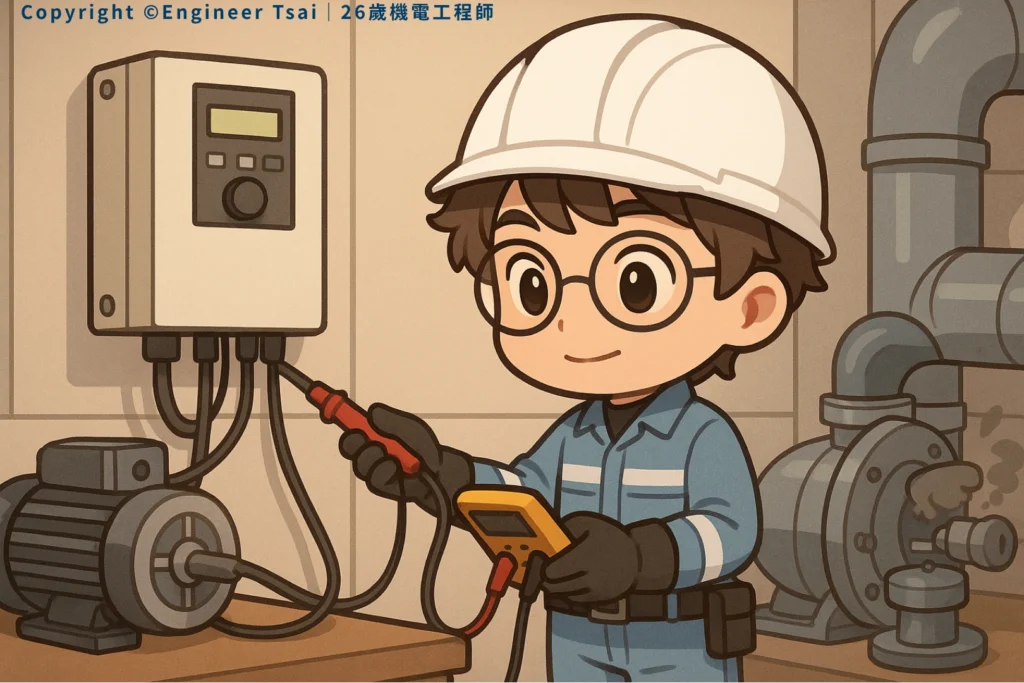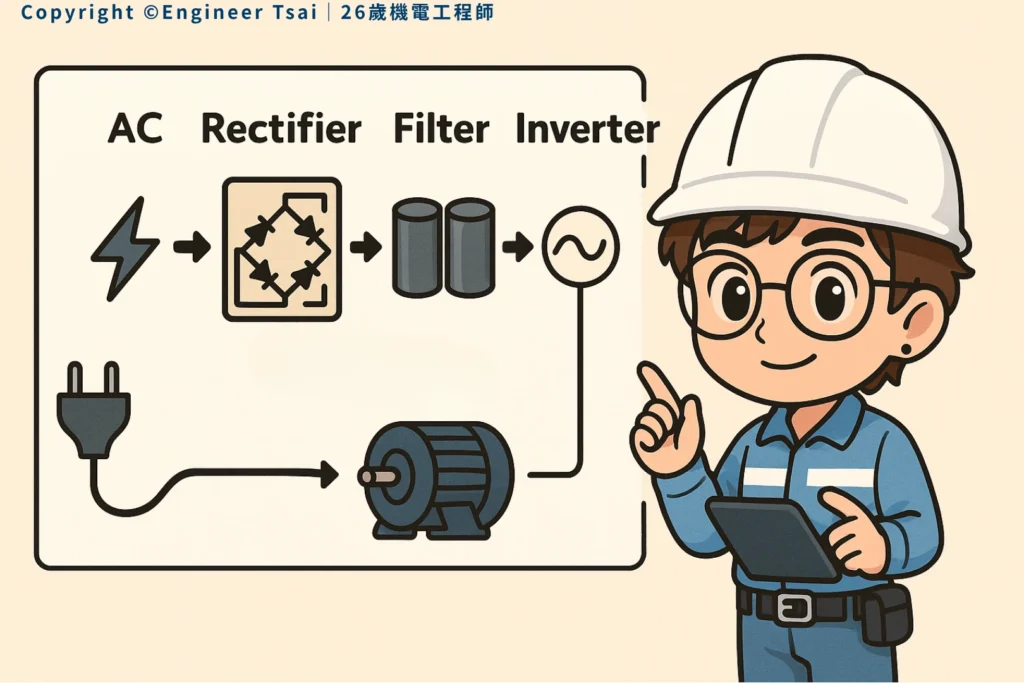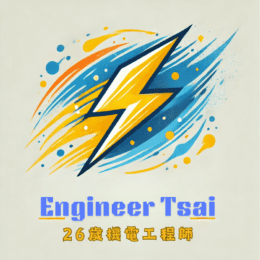▶️ 立即觀看:交流變直流有多難?整流器一次看懂!
你知道嗎?手機、筆電、各種電子設備,其實都吃「直流電」。
但插座送來的卻是交流電——這中間, 整流器 扮演了關鍵角色!
What Are VFDs and How Does It Control a Motor?
You’ve probably heard people say “inverter ACs save more energy,” right? Well, behind that energy-saving magic is something called a Variable Frequency Drive (VFD). Whether it’s in your air conditioner, an industrial machine, or an elevator, VFDs are the unsung heroes of modern motor control.
In this article, we’ll break it all down:
👉 What is a VFD?
👉 How does it control motor speed and torque?
👉 And why is it essential for saving energy, cutting costs, and improving system efficiency?
Chapter 1: Why Do We Need VFDs in the First Place?
Traditional electric motors are pretty straightforward — when you turn them on, they go full speed. That’s it. No in-between, no adjustment based on the actual load or demand.
But here’s the problem with that:
- ⚡ Wasted energy – Motors often run faster than necessary, using more electricity than needed.
- 🧱 More wear and tear – Starting at full speed creates a surge in current that stresses mechanical and electrical components over time.
- 🧭 Lack of control – Fixed-speed motors can’t adapt to real-time changes, making them less efficient in dynamic environments.
This is where VFDs shine.
A Variable Frequency Drive lets you adjust a motor’s speed and torque based on real-time needs. Instead of just “on or off,” your motor becomes flexible and responsive — capable of smooth starts, efficient operation, and intelligent performance in everything from HVAC systems to manufacturing lines.

Chapter 2: How Does a VFD Work?
At its core, a Variable Frequency Drive controls a motor’s speed by adjusting the frequency and voltage of the power it receives. It does this in three key steps:
1. Rectification: AC to DC
The power coming into the VFD is regular AC electricity — just like what you get from a wall outlet. The VFD first converts this into DC (direct current) using a rectifier, usually made of diodes or a bridge rectifier circuit.
2. Filtering: Smoothing Out the DC
This newly converted DC isn’t very clean — it’s still full of ripples. So, the VFD uses capacitors and filters to smooth out the voltage, ensuring a steady, stable DC supply.
3. Inversion: Creating Controlled AC
Finally, the DC is turned back into AC, but here’s the twist — the VFD gets to control the frequency and voltage of this new AC power. Using components like IGBTs (Insulated Gate Bipolar Transistors), it creates a customized AC signal that tells the motor exactly how fast (and how hard) to run.
🧠 Think of it like this: the VFD is your motor’s personal DJ — remixing the power track to set the perfect beat for your machine to groove to.
Chapter 3: How Does It Actually Control Motor Speed?
The speed of an AC motor is directly related to the frequency of the power it receives.
Here’s the basic formula for synchronous motor speed: n=120×fpn = \frac{120 \times f}{p}n=p120×f
Where:
n= motor speed (in RPM)f= frequency of the AC power (in Hz)p= number of pole pairs in the motor
So, if you cut the frequency from 60 Hz to 30 Hz, the motor speed drops in half. A VFD simply takes advantage of this principle: by adjusting the frequency (and voltage), it controls the speed of the motor with precision.
🎯 This is what makes VFDs incredibly powerful — they allow dynamic, real-time speed control, rather than the old-school “on/off” method.
Chapter 4: Real-World Applications of VFDs
You’d be surprised how many everyday systems rely on VFDs for smarter motor control. Here are just a few examples:
🏭 Industrial Equipment
Conveyors, fans, and pumps all use VFDs to adjust speed based on real-time load — improving efficiency and reducing wear.
🌬 HVAC Systems
Inverter-driven compressors help air conditioners run quieter and more efficiently by matching output to room temperature needs.
🛗 Elevators
Smooth acceleration and deceleration improve passenger comfort and reduce mechanical stress.
🧺 Home Appliances
Modern washers and refrigerators use VFDs to match motor speed to feedback from sensors — saving energy and running quieter.
💧 Pumps and Fans
By adjusting motor speed based on pressure or flow requirements, VFDs help systems last longer and operate with less noise.

Chapter 5: VFD Design Tips & What to Watch Out For
Sure, VFDs offer tons of benefits — but choosing and installing one isn’t just plug-and-play. Here are some key things to look out for when you’re working with VFDs in real-world systems:
⚠️ Is Your Motor VFD-Compatible?
Not all motors are built to handle variable frequency. Older or poorly ventilated motors can overheat when run at lower speeds because the cooling fans don’t spin fast enough.
⚙️ Double-Check Frequency and Voltage Settings
Incorrect settings can lead to overheating, torque loss, or inefficient performance. Always match the VFD’s output to your motor’s spec.
🔒 Use the Right Protection Features
Add thermal protection, overload protection, and surge suppression to prevent system failures or premature wear.
🌐 Watch Out for EMI (Electromagnetic Interference)
VFDs can generate high-frequency noise that may mess with nearby electronics. Be sure to include proper grounding and EMI filters in your design.
Conclusion: The Quiet Genius Behind Every Smart Motor
A VFD isn’t the star of the show — but it is the backstage tech that keeps your motor running smarter, longer, and more efficiently.
From skyscraper HVAC systems to high-speed factory automation, VFDs are already powering the modern world behind the scenes. And knowing how to use them properly? That’s the mark of a forward-thinking engineer.
🧠 Learning how to choose, configure, and troubleshoot VFDs isn’t just about saving energy — it’s about designing systems that last longer, fail less, and work smarter.
📌 Suggested Reads (Extended Learning)
🔹 What Is an Electric Motor?(editing)
Understand the differences between AC, DC, and brushless motors — so you know exactly what kind of motor a VFD can handle.
🔹 Voltage & Frequency: How They Impact Motor Performance(editing)
Get deeper into the fundamentals of AC power and learn how changing frequency and voltage affects speed and torque.
🔹 Beginner’s Guide to Industrial Automation(editing)
Explore how VFDs work with PLCs, sensors, and other automation components in smart factory environments.
🔹 Battery in Modern Technology: A Complete Guide
Learn about another key power source — and how battery technology complements systems driven by VFDs.


